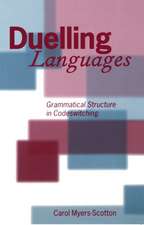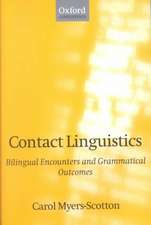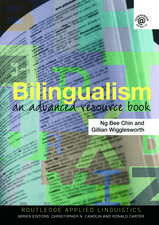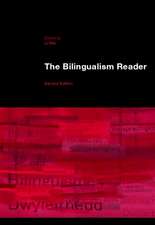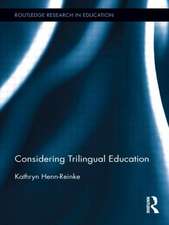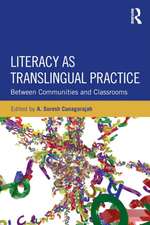English-Medium Instruction at Universities: Multilingual Matters, cartea 149
Editat de Aintzane Doiz, David Lasagabasteren Limba Engleză Paperback – 24 oct 2012
Din seria Multilingual Matters
- 18%
 Preț: 626.63 lei
Preț: 626.63 lei -
 Preț: 297.65 lei
Preț: 297.65 lei -
 Preț: 218.63 lei
Preț: 218.63 lei - 18%
 Preț: 627.05 lei
Preț: 627.05 lei -
 Preț: 191.40 lei
Preț: 191.40 lei - 18%
 Preț: 752.25 lei
Preț: 752.25 lei -
 Preț: 191.49 lei
Preț: 191.49 lei -
 Preț: 292.73 lei
Preț: 292.73 lei - 23%
 Preț: 720.29 lei
Preț: 720.29 lei - 23%
 Preț: 891.83 lei
Preț: 891.83 lei -
 Preț: 259.42 lei
Preț: 259.42 lei -
 Preț: 258.41 lei
Preț: 258.41 lei -
 Preț: 254.80 lei
Preț: 254.80 lei -
 Preț: 304.69 lei
Preț: 304.69 lei -
 Preț: 299.29 lei
Preț: 299.29 lei - 23%
 Preț: 1105.67 lei
Preț: 1105.67 lei -
 Preț: 255.64 lei
Preț: 255.64 lei -
 Preț: 259.64 lei
Preț: 259.64 lei - 23%
 Preț: 776.92 lei
Preț: 776.92 lei -
 Preț: 267.54 lei
Preț: 267.54 lei - 23%
 Preț: 890.81 lei
Preț: 890.81 lei - 23%
 Preț: 775.54 lei
Preț: 775.54 lei - 23%
 Preț: 775.44 lei
Preț: 775.44 lei -
 Preț: 260.96 lei
Preț: 260.96 lei -
 Preț: 255.39 lei
Preț: 255.39 lei -
 Preț: 307.95 lei
Preț: 307.95 lei -
 Preț: 291.57 lei
Preț: 291.57 lei -
 Preț: 296.42 lei
Preț: 296.42 lei -
 Preț: 294.46 lei
Preț: 294.46 lei - 23%
 Preț: 774.98 lei
Preț: 774.98 lei -
 Preț: 298.33 lei
Preț: 298.33 lei - 23%
 Preț: 773.51 lei
Preț: 773.51 lei - 23%
 Preț: 834.91 lei
Preț: 834.91 lei - 23%
 Preț: 777.20 lei
Preț: 777.20 lei -
 Preț: 444.76 lei
Preț: 444.76 lei - 23%
 Preț: 929.72 lei
Preț: 929.72 lei - 23%
 Preț: 721.76 lei
Preț: 721.76 lei -
 Preț: 259.27 lei
Preț: 259.27 lei -
 Preț: 257.13 lei
Preț: 257.13 lei -
 Preț: 318.53 lei
Preț: 318.53 lei -
 Preț: 255.01 lei
Preț: 255.01 lei -
 Preț: 298.91 lei
Preț: 298.91 lei -
 Preț: 254.25 lei
Preț: 254.25 lei - 14%
 Preț: 778.48 lei
Preț: 778.48 lei
Preț: 293.54 lei
Nou
Puncte Express: 440
Preț estimativ în valută:
56.18€ • 58.43$ • 46.38£
56.18€ • 58.43$ • 46.38£
Carte tipărită la comandă
Livrare economică 15-29 aprilie
Preluare comenzi: 021 569.72.76
Specificații
ISBN-13: 9781847698148
ISBN-10: 184769814X
Pagini: 248
Ilustrații: illustrations
Dimensiuni: 147 x 208 x 15 mm
Greutate: 0.32 kg
Editura: Multilingual Matters Limited
Colecția Multilingual Matters
Seria Multilingual Matters
ISBN-10: 184769814X
Pagini: 248
Ilustrații: illustrations
Dimensiuni: 147 x 208 x 15 mm
Greutate: 0.32 kg
Editura: Multilingual Matters Limited
Colecția Multilingual Matters
Seria Multilingual Matters
Notă biografică
Cuprins
Jim Coleman: Foreword Aintzane Doiz, David Lasagabaster and Juan Manuel Sierra: Introduction Part 1: The development of English-medium instruction 1.Robert Wilkinson: English-medium instruction at a Dutch university: Challenges and pitfallsPart 2: Language demands of English-medium instruction on the stakeholders 2.Christa van der Walt and Martin Kidd: Acknowledging academic biliteracy in higher education assessment strategies: A tale of two trials 3.Phillip Ball and Diana Lindsay: Language demands and support for English-medium instruction in tertiary education. Learning from a specific contextPart 3: Fostering trilingual education at higher education institutions 4.David C.S. Li: Linguistic hegemony or linguistic capital? Internationalization and English-medium instruction at the Chinese University of Hong Kong 5.Aintzane Doiz, David Lasagabaster and Juan Manuel Sierra: English as l 3 at a bilingual university in the Basque Country, Spain 6.Josep Maria Cots : Introducing English-medium instruction at the University of Lleida (Spain): Intervention, beliefs and practicesPart 4: Institutional policies at higher education institutions 7.Taina Saarinen and Tarja Nikula: Implicit policy, invisible language: policies and practices of international degree programmes in Finnish higher education 8.Ofra Inbar-Lourie and Smadar Donitsa-Schmidt: Englishization in an Israeli teacher education college: Taking the first steps 9.Ofelia Garcia, Merce Pujol-Ferran and Pooja Reddy: Educating international and immigrant students in US higher education: Opportunities and challenges 10.Elana Shohamy:A critical perspective on the use of English as a medium of instruction at universitiesPart 5: Final considerations 11.Aintzane Doiz, David Lasagabaster and Juan Manuel Sierra: Future challenges for English-medium instruction at tertiary level
Recenzii
As universities throughout the world strive to internationalize, many are introducing English as a medium of instruction. Does this mean the end of other languages as languages of education and scholarship? Or can English co-exist with other languages in higher education? The Chapters in this valuable and highly informative collection examine these and related questions against a range of specific contexts. This should be required reading for all involved in the internationalization of higher education.Andy Kirkpatrick, Griffith University, AustraliaFrom a range of thought-provoking perspectives, this book provides a timely and critical account of the challenges specific to various tertiary contexts where English-medium instruction (EMI) has been implemented. It raises important issues worthy of further reflection and research concerning the effectiveness of EMI, including the perennial challenge of integrating both language and content objectives and the pressing issue of how EMI can be implemented to foster rather than hinder a multilingual mindset.Roy Lyster, McGill University, CanadaUniversities worldwide are increasingly squeezed for resources, and many academics have become wary of buzzwords such as 'internationalization' and 'innovation', linked to 'mobility' and 'quality assurance'. There are concerns that English-medium instruction may sometimes be expediently used as a panacea for coping with market-driven needs without being well enough understood as the very complex phenomenon it is. Addressing many difficult questions head-on, this timely book will be a rich resource for all those who wish to think through for themselves the intricate issues involved in this global trend in an informed and critical way.Barbara Seidlhofer, University of Vienna, Austria

